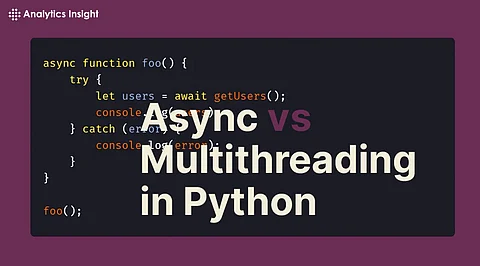

Python allows developers several ways to write concurrent programs. The most notable of these are asynchronous programming and multithreading. These two approaches were designed specifically to improve the performance and efficiency of applications in which tasks can be performed simultaneously. However, they are significantly different in terms of how concurrency is handled. Thus, it is important that developers should know the merits and demerits of both models before deciding to use one of them.
In Python, asynchronous programming allows the use of asyncio, an in-built library that provides techniques for writing programs running concurrently using async and await. In such programming, tasks run under a single-threaded, non-blocking event loop. Rather than idling about waiting for one task to finish, the application can switch to another one, resulting in a more efficient use of CPU time, especially when waiting for I/O-bound operations.
1. Efficiency in I/O-bound tasks: Async is very efficient at dealing with tasks such as API calls, database queries, and file I/O, where the program would otherwise sit idle waiting for responses.
2. Not Resource-Intensive: Async does not require the overhead of creating more than one thread or process, so it saves its resources.
3. Determinism: It will run everything inside a single thread; hence, various concurrency hazards, such as race conditions, deadlock potential, etc., will not occur in it.
4. Scalability: Async code can support thousands of connections at once, making it great for a scalable web application.
1. Learning Curve: To learn to write async code, students will have to prioritize concepts like event loops, async/await, and coroutines, which they may find difficult initially.
2. More Troublesome Debugging: Errors in async code can be more difficult to trace than in a regular program due to the non-linear flow of execution.
3. Only for I/O-bound: Async doesn't serve well in cases of CPU-bound tasks as it doesn't exploit multicore processors.
Multithreading allows the running of various threads concurrently. Python provides a threading module for creating and managing threads. All threads are executed independently and share the same memory space.
1. Parallel Execution: It can allow some operations to be executed in parallel, and this increases performance on certain tasks.
2. Ease of Implementation: Threading concepts is almost simple for those familiar with parallel programming.
3. Compatibility with Blocking Tasks: Used for both I/O-bound and, in some cases, CPU-bound tasks.
4. Improved Responsiveness: Running tasks in the background in a GUI application keeps the interface responsive.
1. Global Interpreter Lock (GIL): The number one disadvantage of Python's multithreading is the GIL—it doesn't allow multiple threads to execute Python bytecode simultaneously in one process.
2. Concurrency Problems: Threads increase the application's complexity due to race conditions, deadlocks, and the problem of synchronizing the processes, which needs to be solved using locks and semaphores.
3. Memory Overhead: The management of multi-threading consumes greater resources before saving memory using async programming.
1. Asynchronous Programming: If activities involve waiting for external resources, then async programming suits them as it's I/O-bound applications such as web servers, database-driven apps, and network requests.
2. Multi-threading: Best suited to background tasks, such as real-time data analysis and GUI operations, or if you need to interface with libraries that don't support async.
Which one to choose - async programming or multithreading in Python? - cannot be answered without speaking of the type of task you have at hand. However, async programming is a modern, efficient option for I/O bound processing and, so to speak, quite scalable and resource-friendly. Conversely, multithreading is still an option for older systems or applications that require real parallelism for their background tasks. Understanding the strengths and limitations of each approach will help you build performant and maintainable Python applications.
